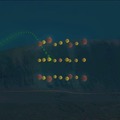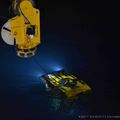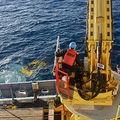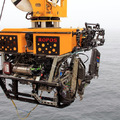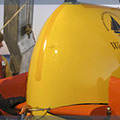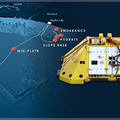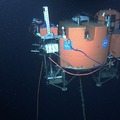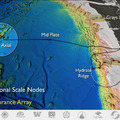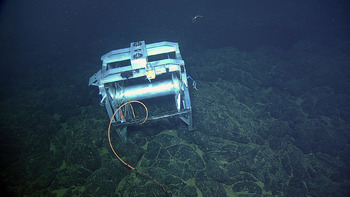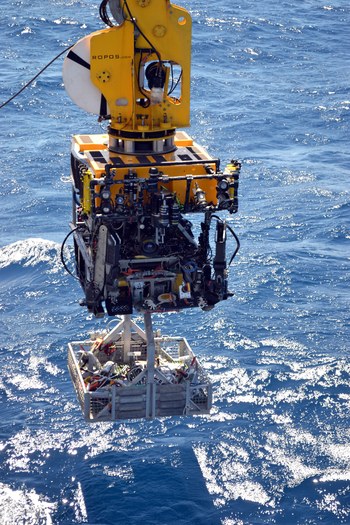
With ROPOS's heavy lift capabilities and industry style latch system on its underbelly, it is able to safely take heavy loads to the seafloor. During the VISIONS'13 Expedition, ROPOS takes two short-period seismometers to the seafloor in the tool basket at the start of Dive 1617 to the caldera of Axial Seamount.
For the OOI Cabled Array, installation, operations and maintenance all require specifically designed capabilities for both the remotely operated vehicle and the secondary infrastructure components to insure efficiency, lowest risk, and highest opportunity for success. Required capabilities include:
- the ability to deploy cables that are up to ~ 5 km in length;
- lift capabilities up to 4,000 lbs;
- latching mechanisms that allow direct coupling of the vehicle to junction boxes (which lowers the risk during the period that the J-Boxes transit through the air-sea interface, and also allows precise positioning of infrastructure on the seafloor);
- 7-function manipulators for ease in sensor deployments, sampling, and coupling and uncoupling of wet mate connectors;
- a variety of environmental sampling capabilities (e.g. vent temperatures, fluid and sediment sampling, CTD);
- tool baskets that provide transport of gear and materials to the seafloor so that the vehicle can continue to operate at the seafloor without surfacing as frequently;
- high quality imaging; and
- precise and accurate navigation (ultra short baseline)
During the VISIONS11-2015 operations, the Cabled Array program utilized the Remotely Operated Vehicle ROPOS operated by the Canadian Scientific Submersible Facility to deploy and test 33,000 m of fiber optic cable, 18 secondary junction boxes, and ~ 140 instruments. All of the cables, junction boxes and cabled instruments were powered up using the custom designed Cabled Interface Box (RIB), which allowed power and communication connections of the ROPOS ROV via a short extension cable to the cable or J-box of interest using a removable wet mate connector. All secondary infrastructure tests were successful and all cables, J-Boxes, and instruments are functional and ready for future activation.


